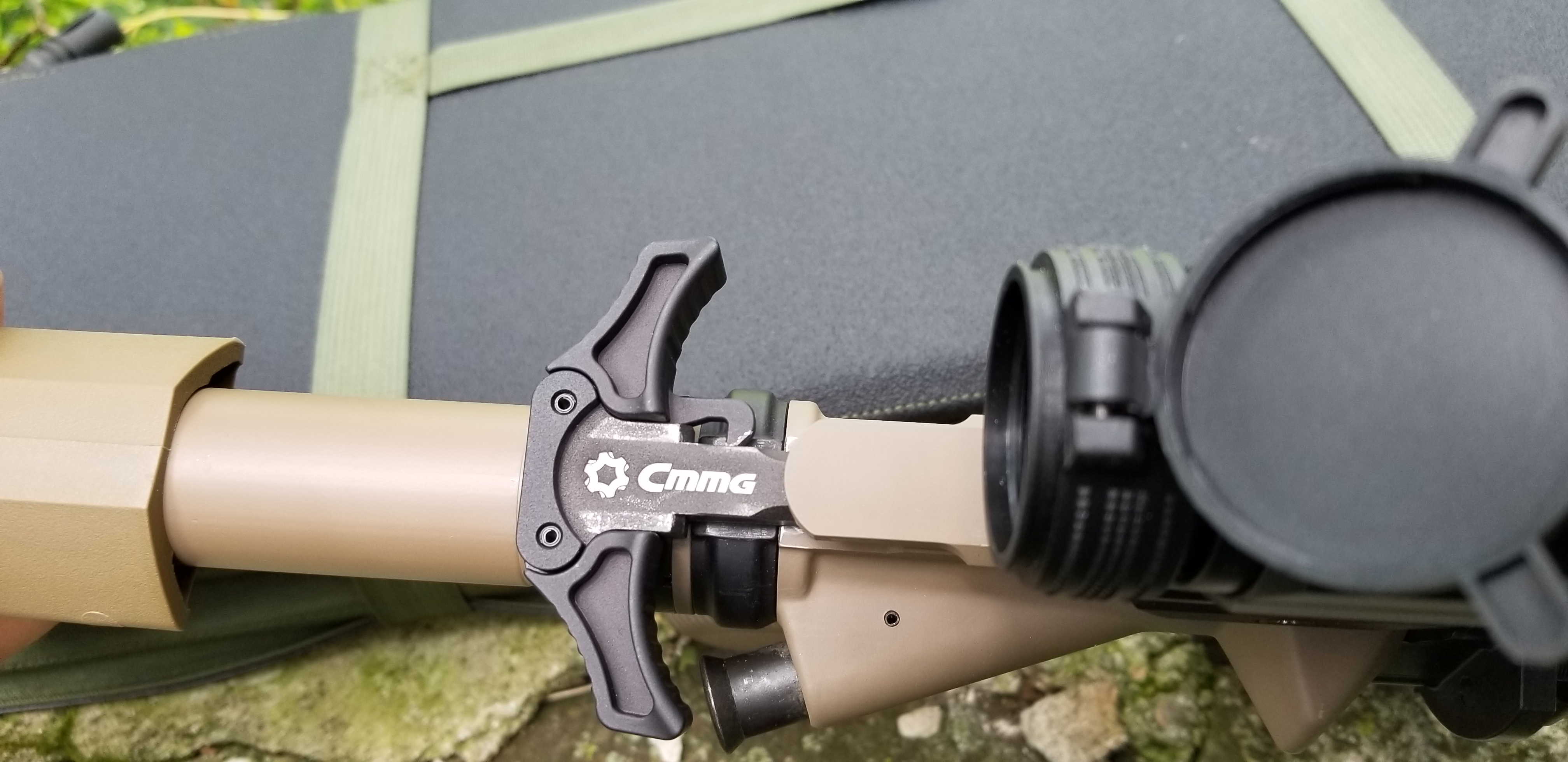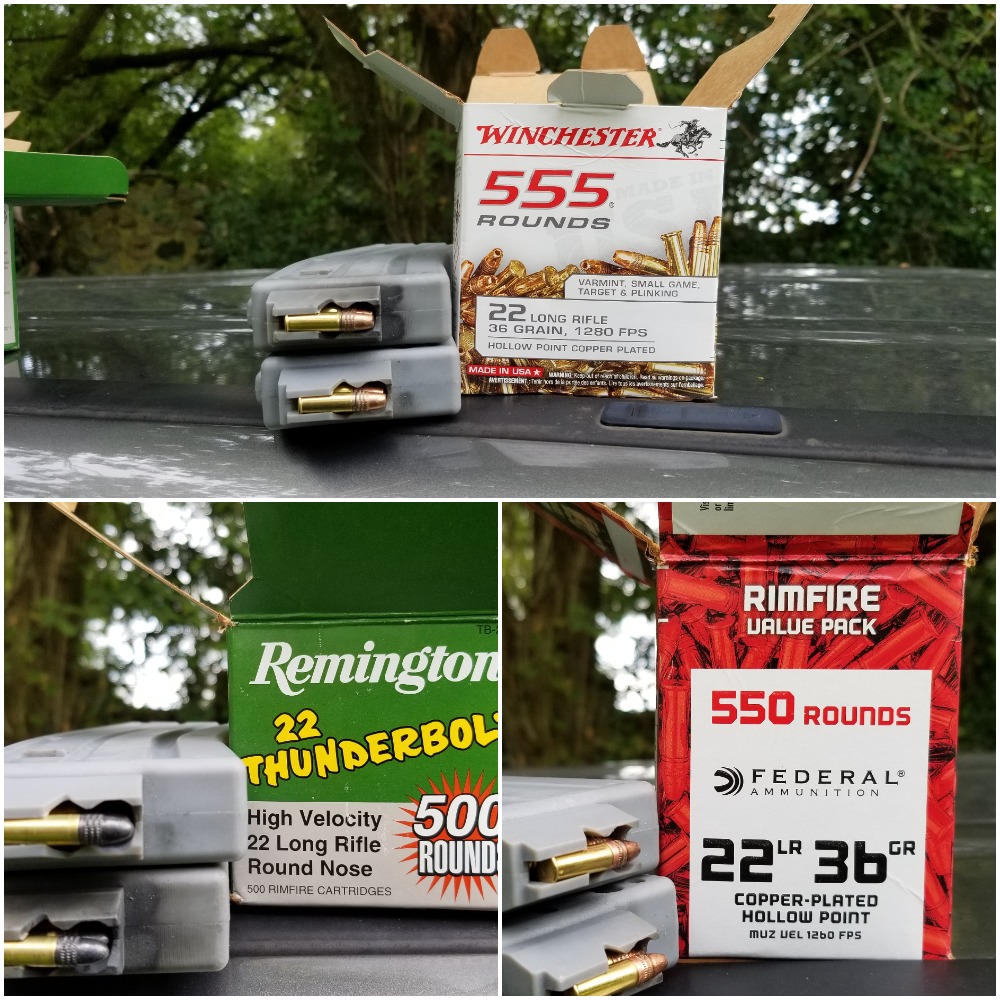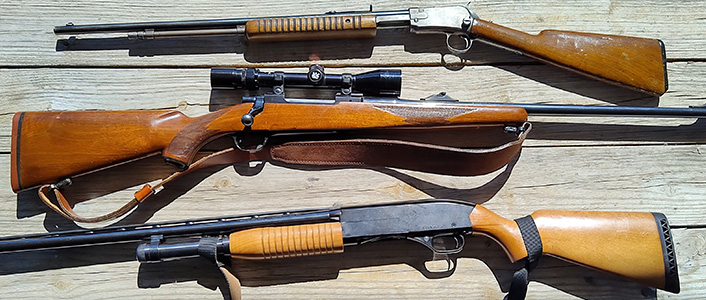The first firearm I ever shot was a single-action .22 rimfire revolver. Though I was only five, it hooked me. I have been a gun guy ever since. While my tastes have meandered through various categories; tacticool, cowboy, military classics, and others, I never abandoned the old .22. It is (except the past draught) inexpensive and easy to come by. It has low recoil and noise. It never fails to put a smile on my face.

A couple of years ago, I was shooting a fun build. It is an AR pistol with a 10.5” barrel. While these are a hoot, they are also particularly loud. I wanted a quieter way to enjoy it so that I could shoot without disturbing the neighbors. That is when I discovered the CMMG .22 LR conversion kit. Switching from 5.56mm to .22 LR is as easy a field strip with this kit. The magazines are the same external dimensions as a typical 5.56 mil-spec magazine, so pouches work well with them to boot. What is different? The noise is greatly diminished, and recoil impulse is virtually nonexistent. What’s most important, however, is that all your controls remain the same, you do not need to learn a new manual of arms to operate your AR in .22.
Not everything is all sunshine and rainbows, however. The downside to the conversion kit is that the rifling rate ideal for 5.56x45mm is not as well suited for .22 LR. Common 5.56 rifling rates are 1:9, 1:8, and 1:7. A typical firearm purpose-built in .22 LR would more commonly have a rifling rate of 1:16. What does this translate to in the real world? It means that while plenty good for plinking or short-range, you will not get the minute of squirrel accuracy we all desire at a distance. When you acknowledge and accept the limitations of running a less than perfect twist rate, you are well rewarded with a capable and fun system.
Reliability with this kit has been stellar. Issues not related to the rimfire priming system are so few and far between that in more than 2000 rounds through the system in various uppers I have had less than a half dozen stoppages. I can’t name a single issue related to the conversion kit. This kit was my very first experience with CMMG, and it certainly was a positive one.

My favorite 5.56 AR is a Franken build. It is something of an homage to the Canadian C7A2 service rifle. My build is as far from clone correct as can be, but is something more akin to a bastardized American stepchild of the C7A2. It is fun for play and reliable for when needed. After shooting it for a while, the thought entered my head that I need a .22 LR dedicated AR with a 20” barrel and a collapsible stock simply because I enjoy the balance and ergonomics. That was when I found out that OpticsPlanet.com sells the complete CMMG uppers, ready to throw on your lower and have fun. While CMMG may no longer offer .22 LR uppers with plastic furniture and fixed front sight towers, they are offering free-float versions with MLOK handguards that are more in line with modern tastes and full power offerings.

CMMG Resolute 100 Rifle Upper
CMMG Resolute 200 Rifle Upper
CMMG Resolute 300 Rifle Upper
CMMG Banshee 100 Pistol Upper
CMMG Banshee 200 Pistol Upper
CMMG Banshee 300 Pistol Upper
While my 20” has been my favorite range toy, it has the same drawback that any 20” barreled AR has, namely overall length. I have found myself craving for something similar but in a more compact package. CMMG has answered this desire with their Banshee series. The Banshee series, is available in a myriad of calibers and can be broken down into three basic trim options (as can their longer offerings for that matter). They are easy enough to keep straight as they are labeled the 100 Series, the 200 Series, and the 300 Series. The higher the number gets, the fancier the build gets, featuring different muzzle devices, barrel lengths, and charging handles. When I discovered the Banshee 300 Series, I knew that I would have to try one out. I am glad to say that with the assistance of CMMG, I am now able to do just that, and share my findings with you.

My first impression upon unpacking the upper is just how short it is. I knew that it had a 4½” barrel and a 4” handguard, but until I held it, I did not fully appreciate how small the whole package is. The muzzle of the CMMG Banshee 300 wears a KAK Slim Flash Can on its ½x28 threads. It certainly adds a fresh look to the upper but importantly it also gives room for forgiveness, keeping the muzzle and the danger away from your hand. Should your local laws allow it; this upper would be awesome combined with a noise-reducing device in place of the flash can. A forward assist is present on the upper and functional since CMMG included their forward assist adapter. The Banshee 300 upper comes with the CMMG Mk4 ambidextrous charging handle. This is a very nice unit, which feels very comfortable in use. After playing with it a bit, I am surprised both by the quality and that I was unaware of its very existence beforehand. I expect that I will be buying some for these for 5.56 NATO uppers in the future.

My first range trip with the upper was tremendous fun. I snapped it on to a lower I have had for some time and then preceded to burn through a brick of Federal .22 LR in short order. I did experience a few issues in the first 100 rounds. Three spent casings became stuck in the charging handle, requiring to be pulled free with pliers from inside the mag-well to rectify the situation. There were also two failures to fire, both of which I attribute 100% to the ammunition and not the upper. Hitting steel targets at 25 yards was effortless and repeatable. Spinning targets designed for full power pistol rounds were possible with fast follow up shots since the Banshee upper was super easy to keep on target.
My Second range trip with the Banshee upper was a couple of weeks later. Unfortunately, it was abbreviated, and I was only able to put approximately a half a box (bulk pack) of ammunition through it. That equates to somewhere between 200 & 300 rounds. In this session, I experienced no malfunctions of any kind. The Banshee continued to impress, as I got more and more comfortable with its small stature. At this time, I took advantage of the Franklin Armory Binary Trigger installed in this lower and ran rounds in rapid succession. The Banshee upper ran and ran with no sign of complaint.

When I had gone through several magazines in binary mode, I had a Cheshire cat smile plastered on my face that I could not remove the rest of the day. A lifelong dream I had, had just been fulfilled, but I should explain further. When I was young (under ten years of age), I was already in love with shooting. My father, being mean and cruel had a rule, however. If I wanted to shoot his 1911 or a revolver (which I enjoyed), I was forced by my taskmaster to de-prime and resize the spent brass. This was accomplished as a single stage on his press. He handled all the other reloading chores that required a greater attention span than a small child was capable of producing. To me, it was still a considerable amount of work, though now as an adult I find that notion laughable. There was a single exception to his rule of having to work the reloading press in return for shooting, and that was .22 LR. I did not understand the reasoning back then. I did not realize that while it may be technically possible to reload .22 LR, it is about as far from feasible as communism on a national level leading to individual freedom.
At this age, I shot a lot of .22 LR because I did not have to do manual labor to do so and because it was plain old fun. My favorite gun at that time was my father’s Ruger 10/22. I had a dream of it being selective fire and figured that it would be just about the coolest thing on the whole planet. Alas, there were two significant hurdles to that. This was after 1986, and we lived in Illinois, which did not allow for NFA toys anyway. I have had opportunity in my adult life to shoot dealer-owned full auto converted 10/22s, but never to own my own. Now, many years later, with the help of the Banshee upper and a Franklin Armory Binary trigger in the lower, I could get very, very close with no need of a tax stamp and the legal headaches that brings. Had CMMG & Franklin Armory offered these back in the late 80’s I would have been begging my father for them for every birthday and holiday. Now as an adult I can finally live out that dream I had a kid. The smile brings to my face is hard to remove.
I have had several range sessions with the Banshee since. Each one was thoroughly enjoyable. With over 2500 rounds through it, from several manufacturers, no more issues occurred (apart from ammunition related rim-fire problems) after the first range session. I decided it was time to see what the upper will do for accuracy when rested, and that was where I found my unexpected hiccup. I compared what the Banshee barrel with its 1:16 rifling designed around .22 LR would group at as compared to the 1:7 barrel that I used in conjunction with the conversion kit. I was able to rest the 10.5” upper with the 1:7 twist barrel easily on it CAR style forend, but there isn’t as much material on the Banshee. This meant that I could not hold it as steadily in a rested position. This upper excels at being handy, performing shoot ‘n scoot techniques, but what makes it great for that hinders it while resting. As such I did not see the considerable dispersion difference in the groups that I expected. I shot three 5 round groups through each upper. One with Federal bulk pack 36 grain HP, one with Winchester bulk pack 36 grain HP, and one with Remington Thunderbolt bulk pack 40 grain LRN. This ammunition selection was chosen for its availability and cost in my local area. The groups were shot at 25 yards. With the Federal, the Banshee was more accurate with an approximately 2” group compared to 3” with the other upper. That trend continued with the Winchester ammunition where the Banshee had a group of roughly 1.5” versus the 2.5” of the other upper. With the Remington ammunition, the trend reversed. The Banshee upper grouped just over 2” while the 10.5” upper with 1:7 twist grouped just under 2”. This shows what we have all known all along, that it is crucial to find out what ammunition your barrel likes when accuracy counts. The Banshee proved more accurate with the bulk pack hollow point that I prefer to shoot, both at targets and varmints.

To place your projectile where you want it, you need a quality sighting system. While irons are readily available and proven, they seemed somehow out of the aesthetic for this upper. To forgo the irons (even on a purely fun gun) would mean that the sighting system should be able to be operated even with no battery power. This would bring to mind a magnified riflescope, but that too would not be keeping with the look and feel of such a short handy upper. To meet this demand I chose the Vortex Spitfire AR prism scope. This site has a dual-circle dot reticle, which lends itself well to fast target acquisition, a primary concern for this short, handy upper. Also of note is that this is a prism scope, not a traditional red-dot sight. This means that while the reticle can illuminate in both red and green, additionally it is 100% visible and usable with no illumination at all. Thanks to this site on the CMMG Banshee upper, no folding iron sights are required keeping the build as handy as possible.

Let us address the elephant in the room. There is not exactly a shortage of good .22 L.R. rifle and pistol designs out there. Some of them are new, while others are more than a century old and enduring. You should be asking by now what sets the CMMG design apart from the other offerings. Why would you choose it over more time-tested options? That answer is multifold. First off is the form factor. The CMMG is built from a real AR upper and handguard. To be clear, when I say real, I mean fully usable with a full power 5.56 barrel and appropriate BCG. This means that the weight is not toy-like, but a true analog for your life and limb choice. If you are comfortable handling your CMMG .22, you will be comfortable in handling your 5.56 as well.
Another point that goes with this is the magazines. They are the same external dimensions as a standard mil-spec 5.56 magazine. This means that you can use the same pouches that you would use when you are serious. That is an especially important concern because not everything works out the way we dream it will when we are shopping. Our best means of finding that out and being honest to ourselves is to put our gear to the test. The CMMG .22 system allows you to both play around (i.e., have fun) and test your gear seriously as well.
Another significant aspect that makes the CMMG .22 uppers stand out in the crowded rimfire market is their very nature. They are designed to work with your favorite AR lower. They are not ascetically similar to, or clones of, but truly an AR platform. This means that they are field-stripped like a 5.56 AR. This is of importance because a great many rimfire designs require tools and patience to clean. For several designs, there is no fieldstrip per se, but only a bench cleaning process. The CMMG .22 design allows one to field strip, quickly wipe down, or thoroughly clean at your discretion, out in world with no need of the sterile workbench to sort small parts that tend to go missing. This cannot be overstated, as it is a huge advantage.
One aspect of the CMMG rimfire magazines that is very different from the mil-spec 5.56 variety is the loading and feeding. This is of course by necessity as they are for a small rimmed round instead of a larger rimless one. As such, the magazines are single feed, single column as opposed to dual feed dual column. In real-life use, this leads to one significant change, namely loading. The magazines can be more tedious to load than their mil-spec counterparts, with more fatigue on your fingers and thumb. CMMG recognizes this limitation and offers a speed-loader to help alleviate the problem. While I have not used one myself it appears to be an item that would lessen any fatigue associated with magazine loading. What I use is a device I learned about from a friend who regularly shoots a CMMG Banshee upper on a registered machine gun lower. I have found the McFadden Machine Lightning Grip Loader to be the fastest most hassle freeloading system out there. When this tool is adequately employed an empty magazine can be fully loaded in only a few seconds. With the addition of this tool to my gear, the CMMG magazines are now the fastest rimfire magazines to load, out of any other in my collection.
The CMMG Banshee 300 upper in .22 LR simply shines bright. It is lightweight, handily petit, accurate, and reliable. What else can you ask for from an upper? The only negative that I can come up with is that no one that has shot this upper wants to stop, leading to a drastic increase of .22 LR usage. As of this writing, .22 LR ammunition has become more and more affordable and available, as it was long ago, so I am ok with this side effect. The massive benefit of fun and the smiles the upper generates more than offset the ammo. Quite simply, if I knew beforehand what I know now, I would have picked up the Banshee upper even sooner, with zero hesitation. I encourage you, dear reader, to do the same, the smiles will emerge shortly after your first use of it.

Build list:
Upper:
- CMMG Banshee 300 Pistol Upper
- Vortex Spitfire 1x Prism Scope
- Magpul MLOK Rail covers
- Ergo Grip Ladder line Rail Covers
Lower:
- Ergo Grip Never Quit Magazine Well cover
- Hogue Trigger Guard
- Tiber Creek Outdoors End Plate
- Guntec USA Buffer Tube
- SB Tactical SBA3 Brace
- Franklin Armory BFSIII Binary Trigger
- Luth-AR Lower Parts KIt
- Mission First Tactical Engage Pistol Grip
- A Rimfire Tale….. - September 4, 2019
- 2018 SHOT Show Experience - March 2, 2018
- 13C Gun Reviews:Nikon Black Force 1000 1-4X24 IL Speed Force Optic - August 1, 2017
Related Posts
« Get Ready for the Raid: The OPMOD Area 51 Kit is Here! OpticsPlanet Presents the 2019 Brilliance Award Winners »



